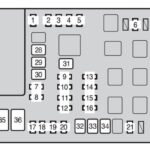Modern vehicles are complex machines, relying heavily on electronic control systems to manage everything from engine performance to safety features. When something goes wrong, your car often tries to tell you through the check engine light or other warning signals. This is where an OBD2 scanner becomes an invaluable tool. But what is an OBD2 scanner, and how can it help you understand and maintain your vehicle?
OBD2, or On-Board Diagnostics II, is a standardized system implemented in most cars and light trucks manufactured after 1996 in the United States (and similar timeframes globally). This system monitors various vehicle components and systems, and when it detects an issue, it stores a diagnostic trouble code (DTC). An OBD2 scanner is a device that reads these codes, allowing you to understand what might be wrong with your car.
Think of an OBD2 scanner as a translator between your car’s computer and you. It plugs into a standardized port, usually located under the dashboard on the driver’s side. Once connected, the scanner can communicate with your car’s computer and retrieve a wealth of information, most importantly, those diagnostic trouble codes.
But an OBD2 scanner does more than just read codes. Many scanners can also provide:
- Code definitions: While a code like “P0300” might seem cryptic, a scanner will translate it into something understandable, such as “Random/Multiple Cylinder Misfire Detected.”
- Live data: See real-time information about your vehicle’s operation, such as engine speed (RPM), coolant temperature, oxygen sensor readings, and much more. This data can be crucial for diagnosing intermittent problems or verifying repairs.
- Freeze frame data: When a fault code is triggered, the system often records a “snapshot” of sensor readings at that exact moment. This “freeze frame” data can provide valuable clues about the conditions when the problem occurred.
- Clearing codes: After a repair is made, an OBD2 scanner can often clear the fault codes and turn off the check engine light. However, it’s important to address the underlying issue first; otherwise, the light will likely return.
For car owners, understanding what is an OBD2 scanner and how to use one can save both time and money. Instead of immediately taking your car to a mechanic for every check engine light, you can use a scanner to get an initial diagnosis. This allows you to be more informed when you do visit a professional, or even tackle simple repairs yourself. For mechanics, an OBD2 scanner is an essential tool for efficient and accurate diagnostics, enabling them to quickly pinpoint issues and provide effective repairs.
While basic OBD2 scanners are readily available and affordable for reading and clearing codes, more advanced scan tools, like the ThinkDiag, offer enhanced capabilities. These may include manufacturer-specific diagnostics, access to more in-depth data, and even bi-directional controls to test components. Regardless of the complexity, the fundamental purpose remains the same: to help you understand your vehicle’s health through the OBD2 system.

